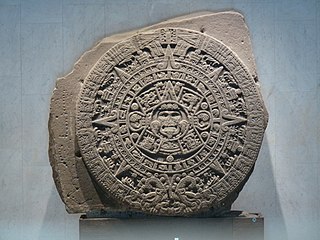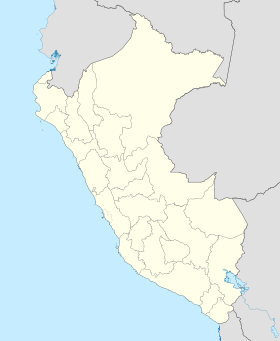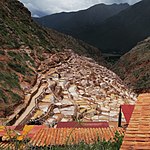
Machu Picchu is a 15th-century Inca citadel located in the Eastern Cordillera of southern Peru on a 2,430-meter (7,970 ft) mountain ridge. Often referred to as the "Lost City of the Incas", it is the most familiar icon of the Inca Empire. It is located in the Machupicchu District within Urubamba Province above the Sacred Valley, which is 80 kilometers (50 mi) northwest of Cusco. The Urubamba River flows past it, cutting through the Cordillera and creating a canyon with a tropical mountain climate. In reference to the site's name, for most English or Spanish speakers, the first 'c' in Picchu is silent. In English, the name is pronounced MAH-choo PEE-choo or MATCH-oo PEAK-choo, in Spanish as or, and in Quechua as.

Pre-Columbian art refers to the visual arts of indigenous peoples of the Caribbean, North, Central, and South Americas from at least 13,000 BCE to the European conquests starting in the late 15th and early 16th centuries. The Pre-Columbian era continued for a time after these in many places, or had a transitional phase afterwards. Many types of perishable artifacts that were once very common, such as woven textiles, typically have not been preserved, but Precolumbian monumental sculpture, metalwork in gold, pottery, and painting on ceramics, walls, and rocks have survived more frequently.

Peruvian architecture is the architecture carried out during any time in what is now Peru, and by Peruvian architects worldwide. Its diversity and long history spans from ancient Peru, the Inca Empire, Colonial Peru to the present day.

Since the 2000s, Tourism in Peru makes up the nation's third largest industry, behind fishing and mining. Tourism is directed towards archaeological monuments, ecotourism in the Peruvian Amazon, cultural tourism in colonial cities, gastronomic tourism, adventure tourism, and beach tourism. According to a Peruvian government study, the satisfaction rate for tourists after visiting Peru is 94%. Tourism is the most rapidly growing industry in Peru, growing annually at a rate of 25% over the past five years. Tourism is growing in Peru faster than any other country in South America. Iperú is the Peruvian national tourist office.

Thierry Jamin is a French explorer and pseudohistorian known for his research about Paititi and the presence of the Incas and pre-Inca civilization in the Amazonian rainforest.
Nicola Masini is an Italian scientist with CNR, noted for his work on exploring traces of Andean civilizations in Peru and Bolivia using spatial technologies and Remote Sensing.
Richard Lewis Burger, Ph.D., is an archaeologist and anthropologist from the United States. He is currently a professor at Yale University and holds the positions of Charles J. MacCurdy Professor in the Anthropology Department, Chair of the Council on Archaeological Studies, and Curator in the Division of Anthropology at the Peabody Museum of Natural History. He has carried out archaeological excavations in the Peruvian Andes since 1975, publishing several books and many articles on Chavin culture, a pre-Hispanic civilization that developed in the northern Andean highlands of Peru from 1000 BC to 400 BC. Burger is married to Lucy Salazar, a Peruvian archaeologist and long time collaborator on many research projects. His former doctoral student Sabine Hyland has become well-known as an Andean anthropologist.




























